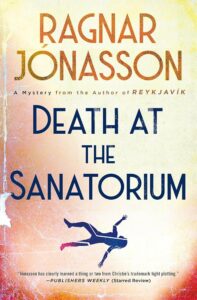 Author Jonasson, an Icelandic fan of Agatha Christie from a child, had read all the available books translated by the time he was 17. At that point, craving more, he simply went to the publisher and asked if he himself could translate more of her previously untranslated titles. They agreed, and Jonasson was treated to a master class in plot, structure, character and setting as he did his work. As evidenced by his own books, the lessons certainly took. Like Christie’s, his books are perfectly structured, have memorably distinctive characters and always feature an evocative setting. Oh, and they are also short, another valuable lesson he gleaned from Agatha.
Author Jonasson, an Icelandic fan of Agatha Christie from a child, had read all the available books translated by the time he was 17. At that point, craving more, he simply went to the publisher and asked if he himself could translate more of her previously untranslated titles. They agreed, and Jonasson was treated to a master class in plot, structure, character and setting as he did his work. As evidenced by his own books, the lessons certainly took. Like Christie’s, his books are perfectly structured, have memorably distinctive characters and always feature an evocative setting. Oh, and they are also short, another valuable lesson he gleaned from Agatha.
His latest brilliant, intelligent, compelling effort, Death at The Sanitorium, is set in the titular building that had previously been used for TB patients. By 1983, when much of the narrative takes place, the site is pretty empty but still kept functional as a research facility with a skeleton staff while the government decides how to dispose of it. One of the nurses, Tinna, is an early riser who always arrives first (thereby gaining overtime at the beginning of the day rather than the end). One morning when she enters the building something seems off – and indeed, when she goes to check in her supervisor’s office, she finds the woman dead, several of her fingers cut off.
The investigation begins, and as readers, we are also sequentially reading a part of the story that takes place in 2012, centered around Helgi, a young man who has decided to investigate the now 30-year-old case for his master’s thesis. Helgi also has something troubling going on with his girlfriend, who wants him to remain in Reykjavik instead of returning to the UK as he had planned, a contentious point between them and for much of the book. Other than investigating this old crime, Helgi’s plans remain up in the air, providing another mysterious thread to the story.
He’s a good investigator, however, and interviews most of the people involved who are still alive. In true golden age fashion, there’s a very tight group of suspects, and questions remain about the initial resolution of the case. It’s true the crimes stopped but most concerned aren’t completely sure the outcome was the correct one. Jonasson also takes the reader inside the lives of the sanitorium staff – nurses, doctors, the building caretaker – and illuminates their lives, past and present.
Jonasson is such a good storyteller that I was unsure of the culprit until the very end of the novel, though, again in classic fashion, the reader is given enough information to theoretically figure it out. The atmosphere of both Reykjavik and the old sanitorium, with its ghosts of TB patients, are certainly distinctive parts of the story as well. Obviously, this is a book that’s been translated, but the crispness and spareness of the prose as well as the tightness of the plot seem to retain some kind of Icelandic ethos. Like all the best writers, Jonasson has taken the lessons he learned from Christie and made the form his own, making this one of the reads of the year. — Robin Agnew